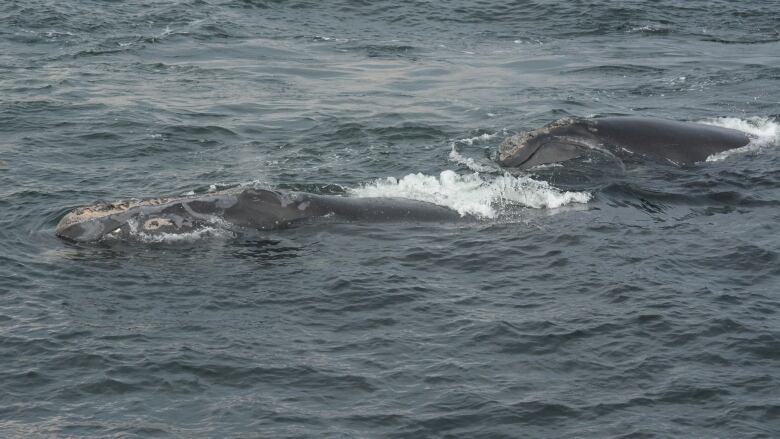4 mother-calf pairs of right whales spotted in Gulf of St. Lawrence
Researchers collect 199 photos of more than 70 North Atlantic right whales in gulf

Four of the seven North Atlantic right whale calves known to have been born this winter made it to the Gulf of St. Lawrence this summer, according to a group of scientists.
Amy Knowlton, a research scientist with the New England Aquarium in Boston, and Kimberly Davies, an assistant professor at the University of New Brunswick, metwith journalists on Wednesday after returning from a 15-day research trip in the region.
Knowlton said the researchers collected 199 photographs of more than70 right whales that have been spottedthis summer,includingfour mother-calf pairs.
"We don't know where the other three are, but four are here and are in good shape," she said in Shippagan, N.B.,on Wednesday.
Twelve North Atlantic right whales were found dead in Canadian waters in 2017, and while there were no deaths in 2018, there were also no births that year.
Earlier this year, researchers breathed a sigh of reliefafter seven right whale calves were seen offthe southern U.S. coast.
'Discouraging entanglements'
During the trip,the scientists spottedthree entangled right whales, which Knowlton said "is a bit discouraging."
The Campobello Whale Rescue Team, with support from government vessels and planes, were able to partially disentangle two of the three whalesand are tracking the third.
Knowlton said scientists also saw individual whales they recognized, and collected skin and fecal samples to test later on.

She said all that data will support long-term studies. They'll also look at the photos in search of "human-related scarring," such as scars caused by entanglement in fishing gear and vessel strikes.
The fecal and skin samples will be analyzed for hormones and genetics,she said.
"So it's sort of a multifaceted effort that we're doing."
Eight right whales have been found dead in Canadian waters this year. Three of the deaths were linked to vessel strikes, and none have been linked yet to fishing gear entanglement.
'Incredibly successful mission'
UNB'sDavies said she was on the boat to study the whale's food source:the rice-sized plankton called copepods.
Crab fisherman Martin Noel, captain of the Jean-Denis Martin boat, took the researchers out on this mission. On the back deck of his boat are a number ofinstruments used to study the foraging behaviour of the whales.
If we can keep from killing them from these human activities, I think the population will thrive and continue to reproduce in more numbers.- Amy Knowlton, New England Aquarium
Davies said understanding the whale's food population and distribution is instrumental in understanding more about what's driving them to come to the Gulf of St. Lawrence. This research will also help scientistsunderstand how much food there is for the whales and whether it's enough to support the population
"Right now [the gulf] seems to be the only viable foraging habitat for these animals in Canadian waters," Davies said.
Davies said they were able to get more than 100 samples near foraging right whales, which makes it "an incredibly successful mission from a data collection standpoint."

Turning the trend around
Although only about 400 whales are left, Knowlton said they arenot "past the point of no return." The whales were hunted to near extinction and, until they were protected in 1935, they were thought to be functionally extinct.
"We've seen numbers as low as 300 in thispopulation starting in the mid-1990s," she said. "If we can keep from killing them from these human activities, I think the population will thrive and continue to reproduce in more numbers."
She said there's no firm number of how low the population can getuntil it's not genetically viable, but "we're nowhere close to that point."
The goal is to reach a few thousand, she said.
With files from Shane Fowler













_(720p).jpg)


 OFFICIAL HD MUSIC VIDEO.jpg)
.jpg)



























































































